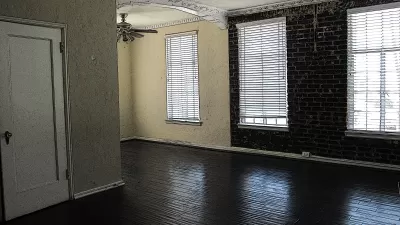Millions of people who live in manufactured homes were already vulnerable. The pandemic has made their housing situations even more precarious.

Jung Hyun Choi and Laurie Goodman write about the impact of COVID-19 on people living in manufactured housing, 7 percent of U.S. households. "These 22 million renters and owners tend to have lower incomes and work in industries that are vulnerable to the pandemic, yet these households mostly fall outside the protections offered by the Coronavirus Aid, Relief, and Economic Security (CARES) Act."
Owners and renters of manufactured homes make up a higher percentage of workers in the industries hardest hit by the pandemic—food and accommodation, retail, construction, entertainment, and other services—compared to owners of single-family homes and other renters. They also have lower incomes than homeowners and other renters.
"Despite their greater vulnerability, most owners of manufactured homes do not qualify for CARES Act forbearance relief, because 77 percent of all new manufactured homes are titled as 'personal property' rather than 'real estate.'" For owners who are able to get forbearance on the "chattel loans" of manufactured homes, the repayment terms are generally less favorable than those for federally backed mortgages.
"Renters also did not receive immediate relief. The CARES Act eviction moratorium, which expired July 24, did not apply to most renters in manufactured homes, with two exceptions: the manufactured home parks financed with federally backed mortgages (2,400 out of 45,000) and the few investor-owned properties with federal loans," note Choi and Goodman.
FULL STORY: 22 Million Renters and Owners of Manufactured Homes Are Mostly Left Out of Pandemic Assistance

Trump Administration Could Effectively End Housing Voucher Program
Federal officials are eyeing major cuts to the Section 8 program that helps millions of low-income households pay rent.

Planetizen Federal Action Tracker
A weekly monitor of how Trump’s orders and actions are impacting planners and planning in America.

Ken Jennings Launches Transit Web Series
The Jeopardy champ wants you to ride public transit.

Rebuilding Smarter: How LA County Is Guiding Fire-Ravaged Communities Toward Resilience
Los Angeles County is leading a coordinated effort to help fire-impacted communities rebuild with resilience by providing recovery resources, promoting fire-wise design, and aligning reconstruction with broader sustainability and climate goals.

When Borders Blur: Regional Collaboration in Action
As regional challenges outgrow city boundaries, “When Borders Blur” explores how cross-jurisdictional collaboration can drive smarter, more resilient urban planning, sharing real-world lessons from thriving partnerships across North America.

Philadelphia Is Expanding its Network of Roundabouts
Roundabouts are widely shown to decrease traffic speed, reduce congestion, and improve efficiency.
Urban Design for Planners 1: Software Tools
This six-course series explores essential urban design concepts using open source software and equips planners with the tools they need to participate fully in the urban design process.
Planning for Universal Design
Learn the tools for implementing Universal Design in planning regulations.
Ada County Highway District
Clanton & Associates, Inc.
Jessamine County Fiscal Court
Institute for Housing and Urban Development Studies (IHS)
City of Grandview
Harvard GSD Executive Education
Toledo-Lucas County Plan Commissions
Salt Lake City
NYU Wagner Graduate School of Public Service





























